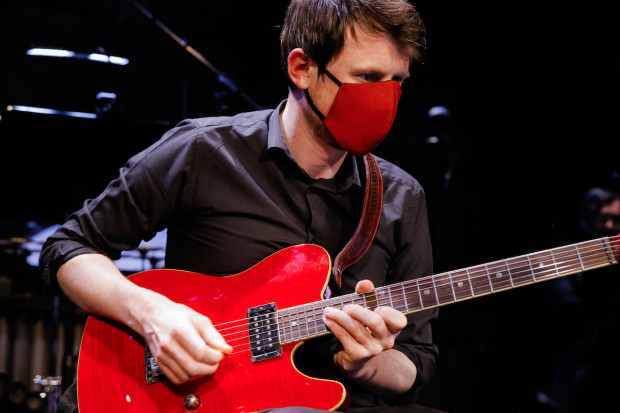
Karen Power listening and recording underneath the sand of the living desert in Namibia. (Photo: John Godfrey)
Love of the Living Sounds
Belying the New York sirens that announce it, Cork-based composer Karen Power’s new album human nature is full of quietude and stillness. Its eighteen tracks, each a ‘duet’ between a live performer and one of Power’s field recordings, are moments out of time, framed and brought into affectionate focus. The recordings range widely (Power has been collecting them since 2012, and many of her works in fact involve field recordings), from a transport hub in Switzerland to underwater frogs in Angkor Wat.
Some of the performers on this album, such as Anne-Marie O’Farrell on ‘loved bees’, respond to their sound sources by way of conversing with them as a human outsider. Some respond by complementing the recording’s sounds: Silke Lange, in ‘a frog and gecko moment from Australia’, supports the animals’ clicks with a soft bed of chords. Others lose themselves in the recording: John Godfrey, on ‘bats of Namibia’, joins the chorus of echolocating clicks so closely that it is almost impossible to discern which clicks are his. Caoimhín Ó Raghallaigh, on ‘unique ecosystem of Garig Gunak Barlu National Park’, finds a counterpoint latent in the field recording that sets off its bird chirps gorgeously.
Each performer on human nature, many of whom are composers in their own right, responds in their own way, and there is a lovely breadth of approach in this album. Among the other performers are Samuel Stoll on the opening track, veteran baritone Thomas Buckner, and singer Michelle O’Rourke and cellist Anne Bourne. But none of the performers are violent to their sounds, and the focus in each piece is on the field recordings, with the performers almost enacting a listening any of us might give to these sounds, and in so doing encourage us to listen too. The performances, which we are already trained to closely attend to, lead us to listen to the field recordings with the same attentiveness.
In saying that any of us might listen to these sounds, I do not mean to downplay the performances: to listen and respond as sensitively, as imaginatively, with as light a touch, and as selflessly as every performer on this album has done exhibits wonderful musicianship.
This shared approach to the field recordings gives the album a satisfying coherence despite the number and variety of its tracks, and despite the fact that each one stands alone, neither leading to nor from its neighbours. The way these ‘miniatures’ stand alone instead structures the album like a white-cube picture-gallery. When something changes within a track, it feels like you are turning your focus to a different part of a picture all of which is always present: it does not feel like the musical ‘argument’ is progressing. This is as it should be: although train journeys and seals’ barks take place over time, the soundscapes they comprise do not ‘progress’ in the way music does. To impose a temporal structure on such scenes would be to distort them.
Similarly, moving from one piece to the next feels like making your way to the next white-bordered picture along the gallery wall, not like you have ‘finished’ with the first one. You could easily go back to it to re-examine some curious detail you had not properly taken in on first viewing.
The sum effect of the album is not quite stillness, for though it has plenty of that, it is also full of the scuttling movements of what the field recordings captured. Rather, the effect is of stasis. These soundscapes, it seems, could go on for eternity; they are not ‘for’ us, they do not take place on our timescale.
Power’s performers, as is frequently the case in her music, do not perform from traditional scores. The performers are each given their field recording track, but are also, according to her sleeve notes, given ‘a text score and an aural part. These each partially direct their listening and offer specific guidance as to the timing and shape of their response.’ The album, then, is deeply collaborative, with Power playing producer or bandleader as much as composer, creating coherence between the naturally idiosyncratic interpretations of each performer.
Whatever name we give to Power’s contribution – ‘composer’ seems as fitting as any – the result, in its well-directed attentiveness and gentleness, is a wonderful album. I initially thought that the connection Power makes in the sleeve notes to Covid-19 was opportunistic: after all, Power has been working with combining field recordings with live instruments for years, and this album was conceived prior to the onset of the pandemic. However, this said, the album does express a love of travel and the serendipitous encounters one makes when exploring unfamiliar places. Power’s field recordings are taken everywhere from Namibia to Offaly, and the performers hail from New Zealand to Berlin. human nature most immediately expresses Power’s love of the living sounds of humans and of nature – but it also expresses her love of hunting them out, and finding people to play with them. This is love of a thing that Power cannot have with this plague hanging over us, and it is also a thing that I love, and a thing from which I too am kept. Perhaps it is this that explains why an album of bird chirrups and engine churns fills me so.
human nature by Karen Power is available to purchase from Bandcamp: https://composerkarenpower.bandcamp.com/album/human-nature. For more on her work, visit http://karenpower.ie/index.html.
Click on the image below to listen.
Published on 7 October 2020
James Camien McGuiggan studied music in Maynooth University and has a PhD in the philosophy of art from the University of Southampton. He is currently an independent scholar.

















